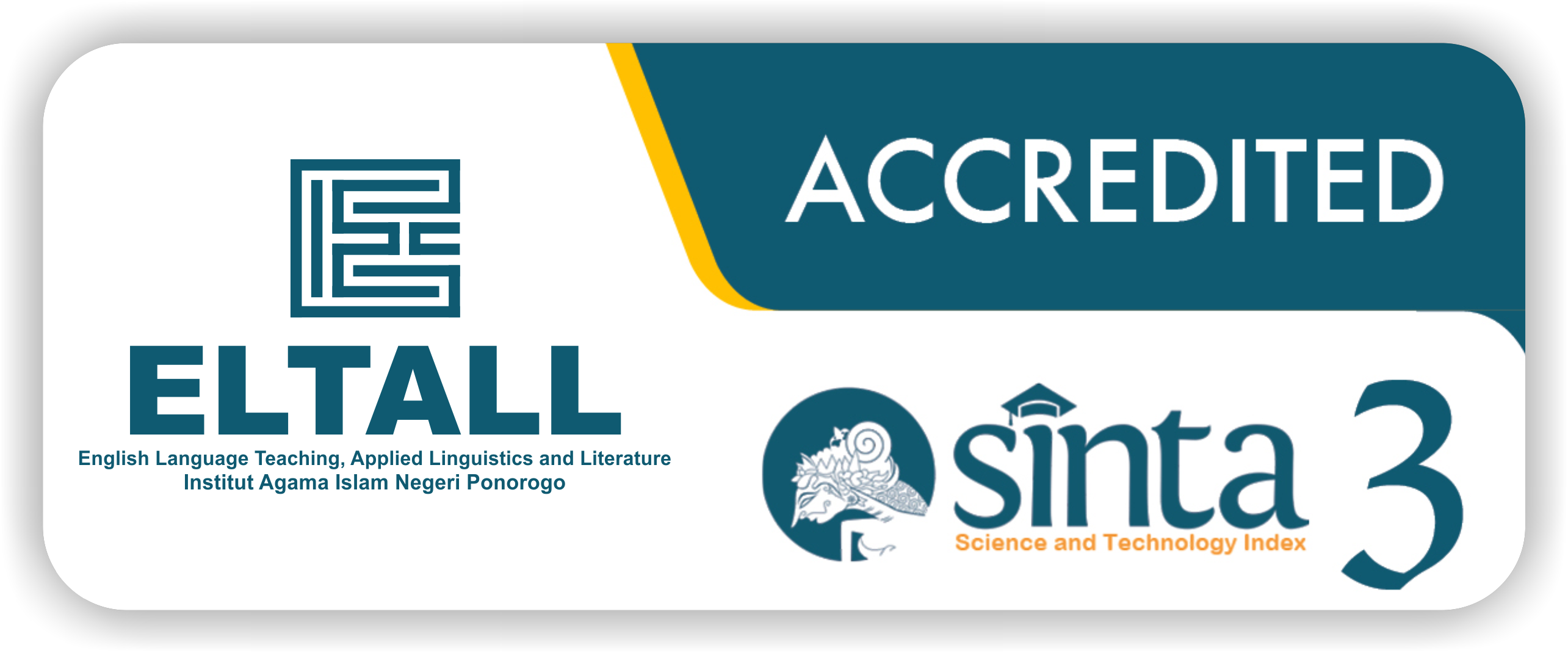An Adaptive Blended Learning in English Language Teaching
DOI:
https://doi.org/10.21154/eltall.v4i1.5854Keywords:
blended learning, English language teaching, EFL studentsAbstract
The post-Covid-19 outbreak exposes vulnerabilities in the educational system. The learning process shifts from online to blended learning. This article aims to describe the process of adapting blended learning for English education students. This article discusses the process of applying blended learning to English education students, the difficulties of doing so, and the impact on students who learn using blended learning at IAIN Ponorogo. This research was conducted on 6th-semester English education students at IAIN Ponorogo. The findings of this study show that the lectures were conducted in blended learning in the English education department at IAIN Ponorogo. The students said that blended learning helps them to understand the material easily. The finding of this study also revealed a positive impact experienced by students. Adaptive blended learning provides the students with new experiences as it combines virtual face-to-face learning and classroom interaction.
References
Al Zumor, A. W. Q., Al Refaai, I. K., Eddin, E. A. B., & Al-Rahman, F. H. A. (2013). EFL Students’ Perceptions of a Blended Learning Environment: Advantages, Limitations and Suggestions for Improvement. English Language Teaching, 6(10), 95”“110.
Brown, H. D. (2002). English Language Teaching in the “Post-Method” Era: Toward Better Diagnosis, Treatment, and Assessment. Methodology in Language Teaching: An Anthology of Current Practice, 9, 18.
Bukhari, S. S. F., & Mahmoud Basaffar, F. (2019). EFL Learners’ Perception about Integrating Blended Learning in ELT. Arab World English Journal (AWEJ) Special Issue on CALL, 5.
Cresswel, J. W. (2010). Research Design: Pendekatan Kualitatif, Kuantitatif, dan Mixed. Pustaka Pelajar.
Fahlvik, M. (2014). The Teacher’s Role in the Blended Classroom. In Practical Applications and Experiences in K-20 Blended Learning Environments (pp. 239”“248). IGI Global.
Fazal, M., Panzano, B., & Luk, K. (2020). Evaluating the Impact of Blended Learning: A Mixed-Methods Study With Difference-in-Difference Analysis. TechTrends, 64, 70”“78.
Greving, S., Lenhard, W., & Richter, T. (2020). Adaptive Retrieval Practice with Multiple-Choice Questions in the University Classroom. Journal of Computer Assisted Learning, 36(6), 799”“809.
Hardiansyah, M. A., Ramadhan, I., Suriyanisa, S., Pratiwi, B., Kusumayanti, N., & Yeni, Y. (2021). Analisis Perubahan Sistem Pelaksanaan Pembelajaran Daring ke Luring pada Masa Pandemi COVID-19 di SMP. Jurnal Basicedu, 5(6), 5840”“5852.
Hernández, Y., & RamÃrez, M. P. (2016). Adaptive and Blended Learning for Electrical Operators Training. Proceedings of the 8th International Conference on Computer Supported Education.
Hockly, N. (2018). Blended Learning. ELT Journal, 72(1), 97”“101.
Hrastinski, S. (2019). What Do We Mean by Blended Learning? TechTrends, 63(5), 564”“569.
Lynch, R., & Dembo, M. (2004). The Relationship between Self-Regulation and Online Learning in a Blended Learning Context. International Review of Research in Open and Distributed Learning, 5(2), 1”“16.
Nguyen, L. T. H. (2021). Teachers’ Perception of ICT Integration in English Language Teaching at Vietnamese Tertiary Level. European Journal of Contemporary Education, 10(3), 697”“710.
Olah, D. A. (2019). Technology Tools for Integration in the Classroom. In Faculty Roles and Changing Expectations in the New Age (pp. 101”“114). IGI Global.
Pardede, P. (2012). Blended Learning for ELT. Online Submission, 2(3), 165”“178.
Picciano, A. G., Dziuban, C., & Graham, C. R. (2014). Blended Learning. Routledge London, UK.
Puspitasari, D. (2021). Blended Learning Environment: Promoting Learners’ Self-Efficacy. ELTALL: English Language Teaching, Applied Linguistic and Literature, 2(1), 39.
Sasan, J. M. V., & Rabillas, A. (2022). Multimedia English Teaching Approach Based on Constructivist Learning Theory. ELTALL: English Language Teaching, Applied Linguistic and Literature, 3(2), 51”“65.
Shahroom, A. A., & Hussin, N. (2018). Industrial Revolution 4.0 and Education. International Journal of Academic Research in Business and Social Sciences, 8(9), 314”“319.
Singh, H. (2021). Building Effective Blended Learning Programs. In Challenges and opportunities for the global implementation of e-learning frameworks (pp. 15”“23). IGI Global.
Susanti, D. I., & Prameswari, J. Y. (2020). Adaptasi Blended Learning di Masa Pandemi COVID-19 untuk Pembelajaran Bahasa Inggris di Sekolah Dasar. Lingua Susastra, 1(2), 50”“61.
Tomlinson, B., & Whittaker, C. (2013). Blended Learning in English Language Teaching (Vol. 252). British Council.
Downloads
Published
Issue
Section
License
All articles published in ELTALL (English Language Teaching, Applied Linguistics, and Literature Journal) are licensed under the Creative Commons Attribution-NonCommercial 4.0 International License (CC BY-NC 4.0).
Under this license, authors and readers are free to:
- Share. copy and redistribute the material in any medium or format
- Adapt. remix, transform, and build upon the material
Under the following terms:
- Attribution. You must give appropriate credit, provide a link to the license, and indicate if changes were made. You may do so in any reasonable manner but not in any way that suggests the licensor endorses you or your use.
- Non-Commercial. You may not use the material for commercial purposes.
Notices:
- The licensor cannot revoke these freedoms as long as you follow the license terms.
- No additional restrictions. You may not apply legal terms or technological measures that legally restrict others from doing anything the license permits.
For the full legal code of the license, please visit: https://creativecommons.org/licenses/by-nc/4.0/













